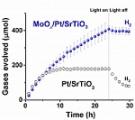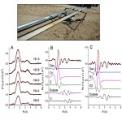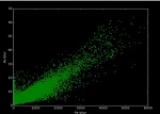Bacterial cells have subcellular features that function as organelles called microcompartments. Bacterial microcompartments organize cellular metabolism. These compartments help increase reaction rates by colocalizing reaction components. They can also sequester sensitive or damaging reactants or products from the rest of the cell. Part of bacterial microcompartment function is to allow only some molecules to cross into the compartment while keeping out others. How this selectivity is possible is not well understood.
Approximately 1,700 scientists visit SSRL annually to conduct experiments in broad disciplines including life sciences, materials, environmental science, and accelerator physics. Science highlights featured here and in our monthly newsletter, Headlines, increase the visibility of user science as well as the important contribution of SSRL in facilitating basic and applied scientific research. Many of these scientific highlights have been included in reports to funding agencies and have been picked up by other media. Users are strongly encouraged to contact us when exciting results are about to be published. We can work with users and the SLAC Office of Communication to develop the story and to communicate user research findings to a much broader audience. Visit SSRL Publications for a list of the hundreds of SSRL-related scientific papers published annually. Contact us to add your most recent publications to this collection.
CRISPR, a powerful new tool that can target and change specific sequences of DNA, is based on a prokaryotic immune system response. The first step of bacterial immunity via CRISPR is placing sequences of foreign (viral) DNA between specific palindromic DNA repeats in the bacterial genome. The enzyme complex Cas1-Cas2 must target the correct DNA locus for integration, since insertion of the viral DNA into other areas of the genome may cause damage to the bacteria.
Diatoms, single-celled marine algae that create beautiful, symmetric cell walls composed of silica, are critical to ocean ecosystems. Responsible for up to 20% of photosynthesis in oceans, these phytoplankton are also an important part of Earth’s carbon cycles. The potential of diatoms and other phytoplankton to sequester atmospheric CO2 has led to geoengineering ideas like “iron fertilization” of oceans.
Molecular hydrogen (H2) is a promising carrier of energy for a future that uses more sustainable sources of fuel. H2 created from splitting H2O using renewable energy methods could result in no carbon footprint energy use. While methods of water splitting are being developed, reverse reactions are a problem.
The radioactive element uranium is well-known for its role in nuclear energy. People mine naturally occurring uranium from deep sandstone deposits called roll fronts. Scientists have long thought that abiotic chemical reactions that occur over millions of years resulted in formation of crystalline uranium. An international team of scientists has challenged this basic theory, finding evidence for a different genesis for uranium in roll front deposits.
Using data collected at SSRL Beam Line 12-2, a team of scientists have determined the molecular structure formed between the Zika envelope protein and neutralizing human antibodies.
While scientists recognize that oxygen-free soil stores large amounts of carbon, knowledge about the processes that protect and preserve carbon-rich molecules in these environments is lacking. In oxygen-rich soil, microbes break down organic molecules through aerobic respiration, allowing carbon to escape the ground as carbon dioxide gas.
Famous for their role in the process of aging, telomeres are the regions of repetitive DNA sequences at the ends of our chromosomes. These repeats are critical for preserving the structure and function of our DNA in concert with numerous cellular factors. One factor responsible for the regulation and maintenance of telomere length is the shelterin complex, composed of six proteins including one called POT1.
An intracerebral hemorrhage (ICH) stroke occurs when a blood vessel bursts inside the brain and blood leaks into brain tissue. Secondary damage is caused by hemoglobin iron making free radicals that cause oxidative damage to brain cells. While prompt rehabilitative therapies have been shown to limit damage, the mechanism for this is unknown.
Coal-ash spills in Tennessee and North Carolina rivers have prompted concerns that toxic trace elements like arsenic could be concentrated in the food web to potentially affect humans. At the base of these freshwater food webs are periphyton biofilms, which contain a complex ecosystem of micro-organisms including bacteria, fungi, diatoms, and algae. Such biofilms can concentrate trace elements hundreds to thousands of times. To investigate whether arsenic concentrated in biofilms is propagated up the food chain, a team of scientists has studied the bioavailability of arsenic to organisms that feed on the periphyton biofilms.














